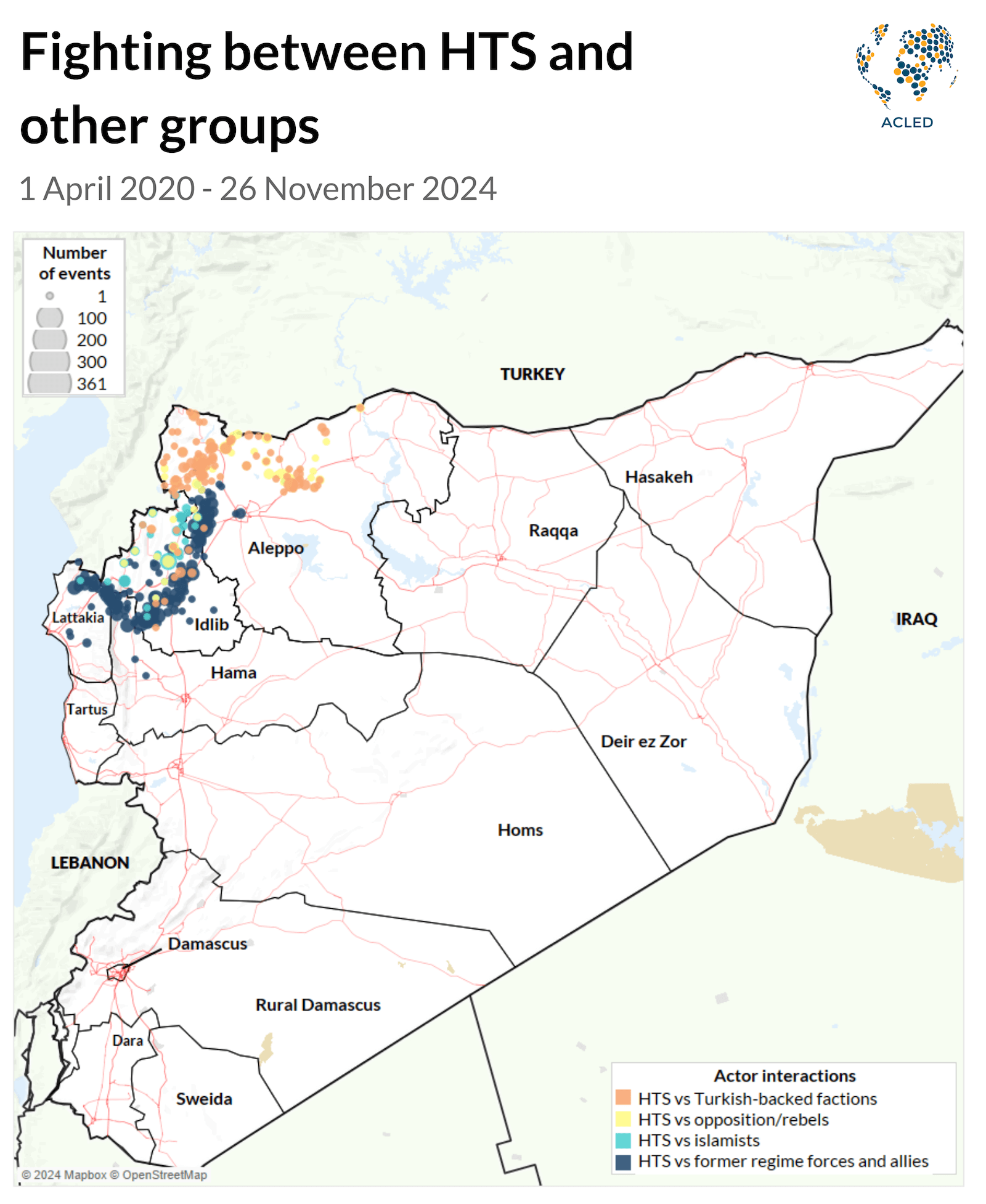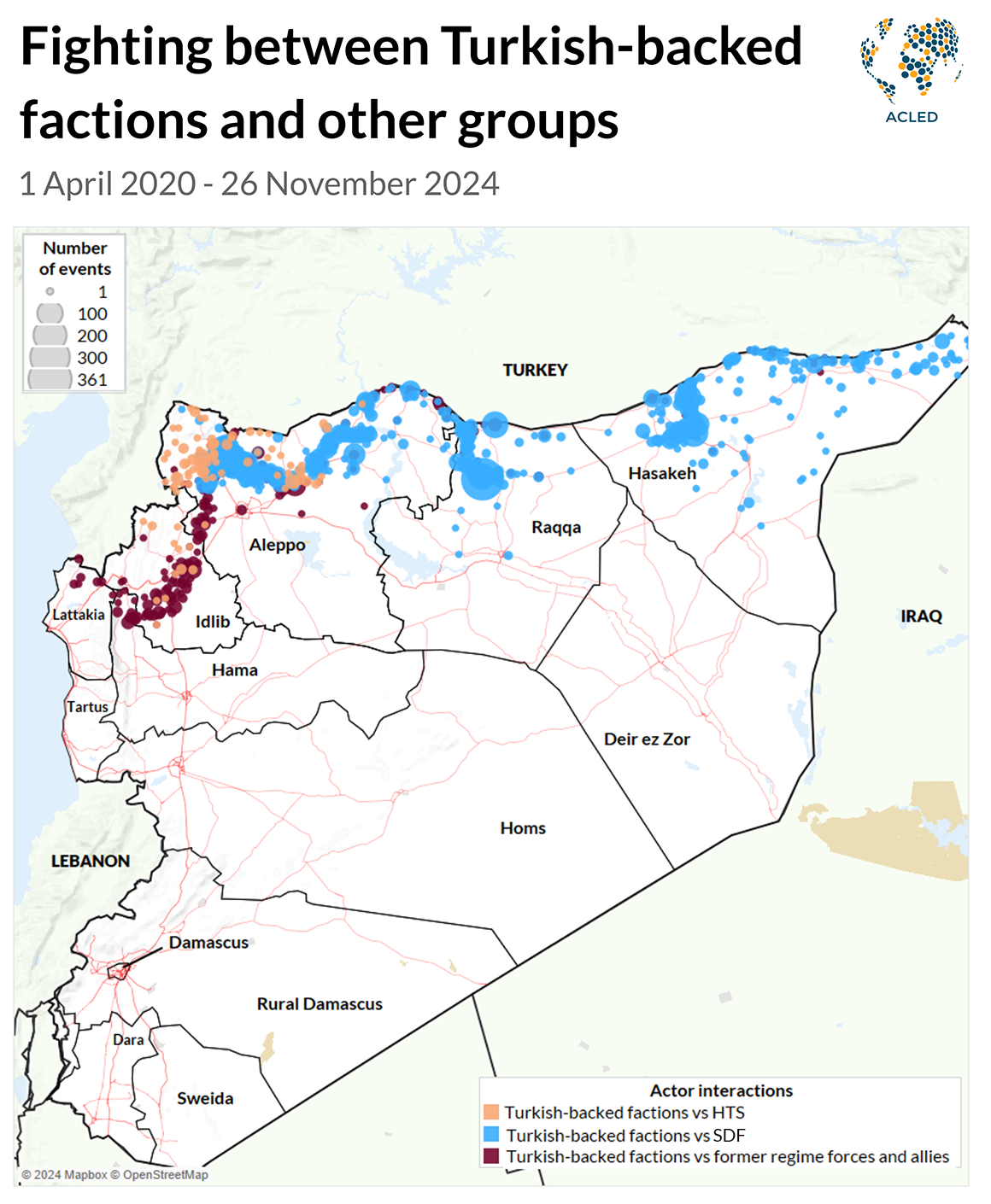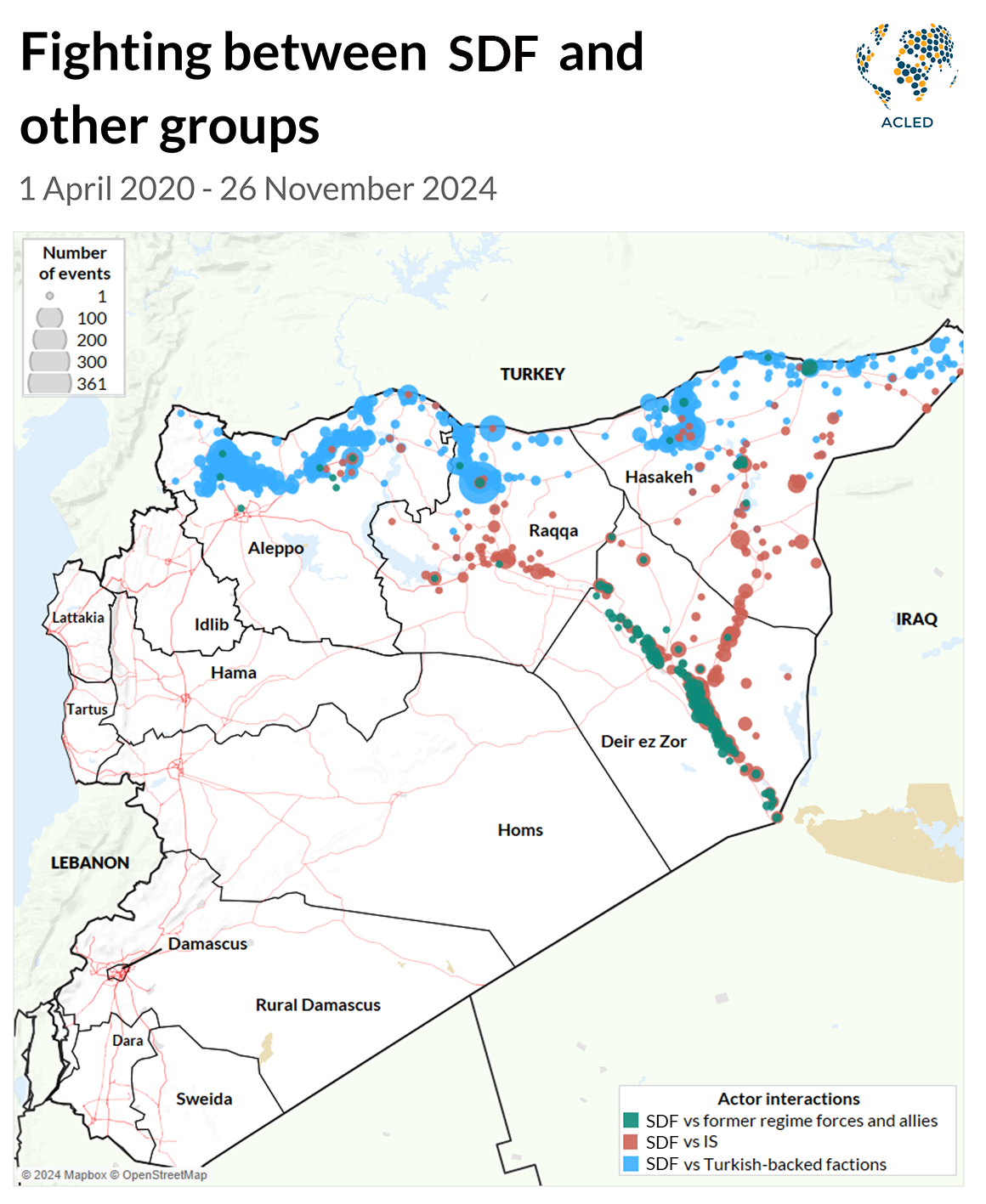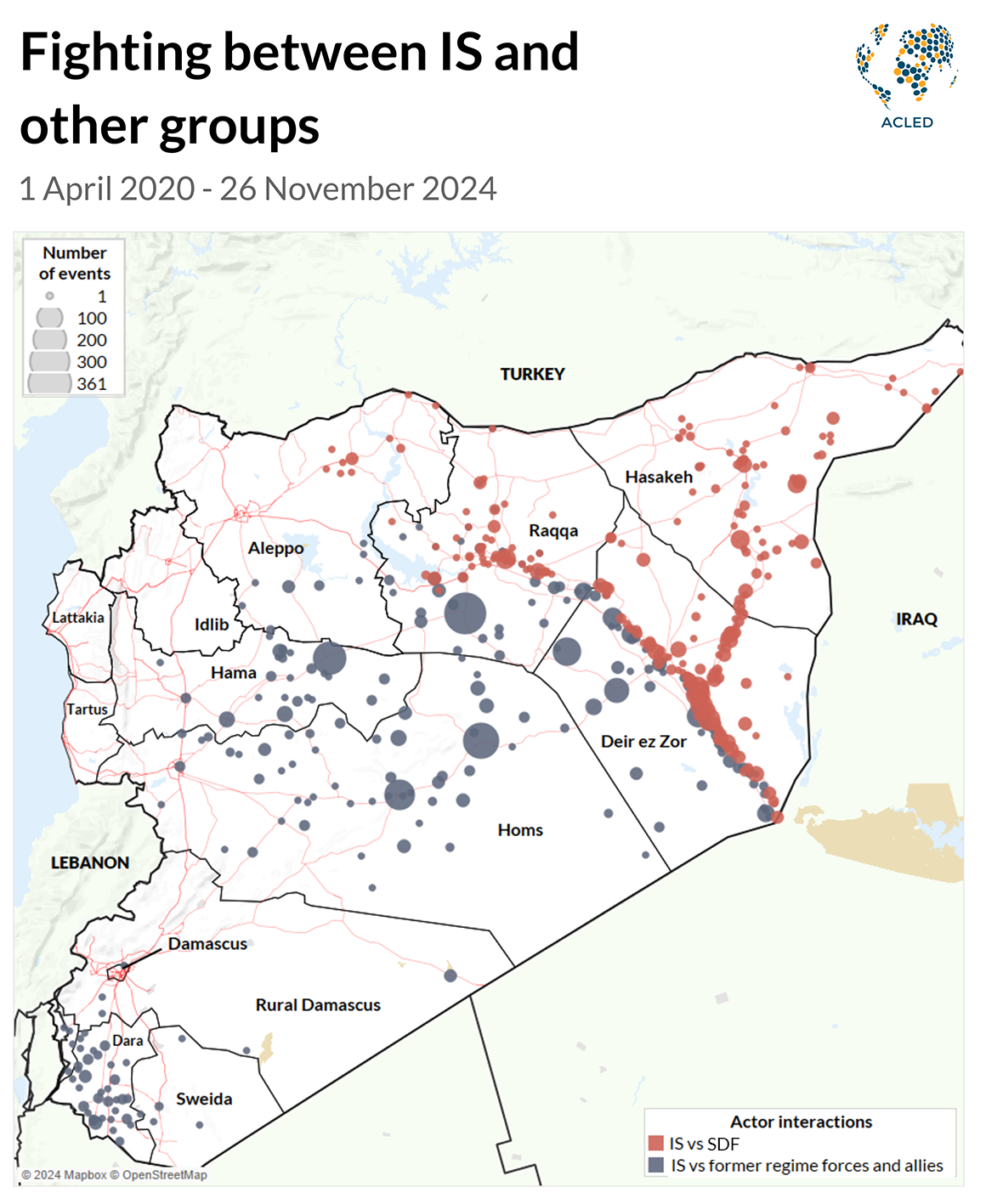Despite the recent coordination between opposition groups in the Military Operations Command (MOC) coalition led by Hayat Tahrir al-Sham (HTS), the future shape of Syria remains uncertain due to historical hostilities and ongoing divisions among the different armed groups throughout the country. ACLED data highlights previous confrontations between these groups since April 2020, when the territorial control of the country was frozen (see maps below). Although Islamic State fighters no longer control territory in Syria, their interactions with key actors — including the Syrian Democratic Forces (SDF) — remain an important dimension of the conflict.
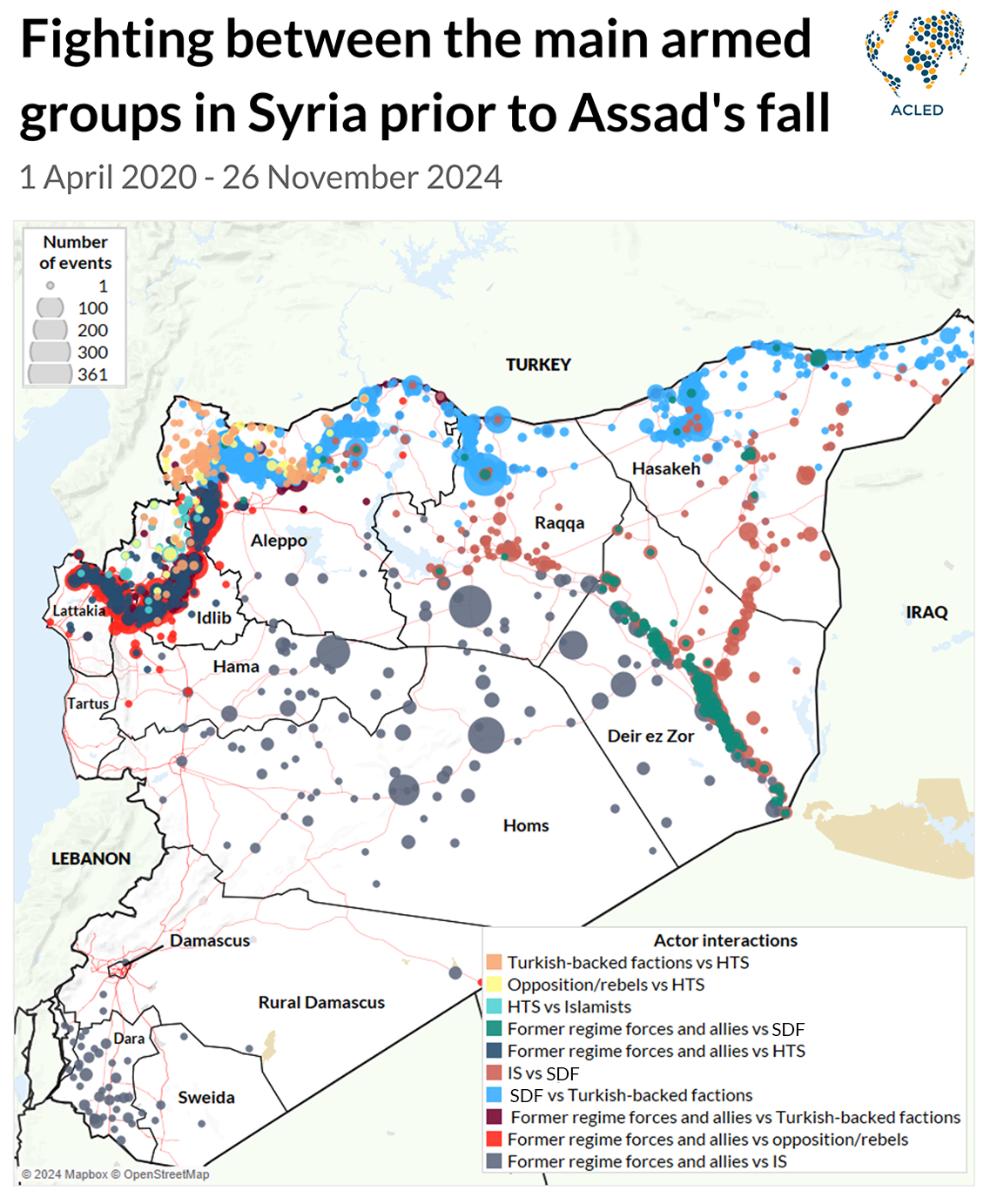

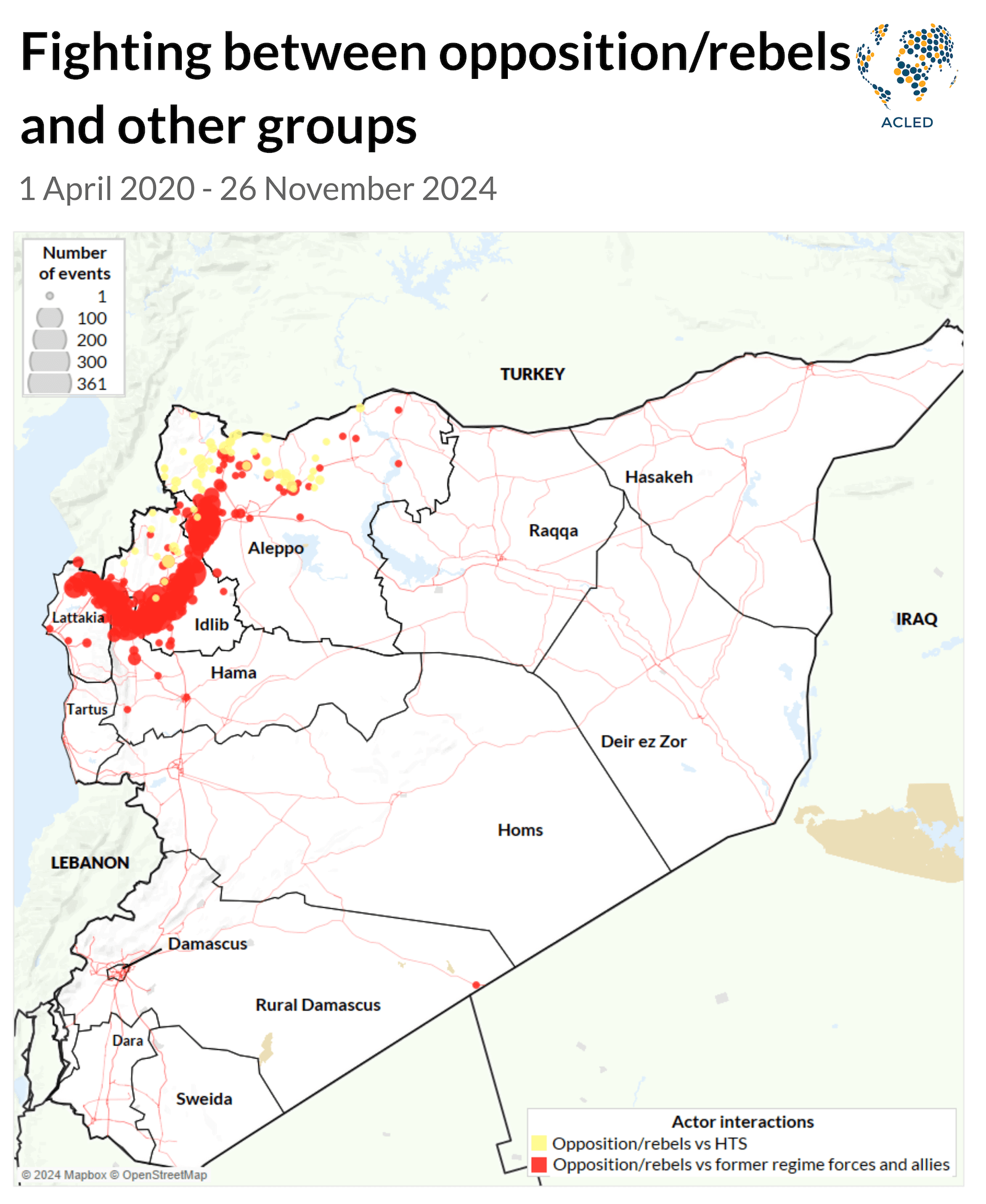
HTS-led coalition of opposition and rebel groups: the Military Operations Command (MOC)
The coalition is led by HTS, the dominant armed group in northwest Syria that rose to prominence when it secured its control over the Idlib enclave after internal opposition fighting since 2017. During this time, HTS eliminated or absorbed other factions, often forcing rival groups into Turkish-controlled territories in the north or fully dissolving them.
HTS’s efforts to distance itself from extremist ideologies further shaped its relationship with other Islamist factions. Offensives against groups like Hurras al-Din in late 2019 and Ahrar al-Sham in 2017 allowed HTS to either dissolve these rivals or fully subordinate them. The capture or killing of their leaders reinforced HTS’s control over Idlib.
While HTS was involved in direct confrontation with rebel and Islamist factions besides the former regime forces in Idlib along the frontlines of Idlib enclave, its activities extended to the areas in northern Syria controlled by Turkish-backed factions. ACLED data show several confrontations in northern Syria between HTS and its affiliates against different Turkish-backed factions of the Syrian National Army (SDA) (see map below). This included Jaysh al-Islam, a group that used to operate in Rural Damascus but was deported by the former Syrian regime following the reconciliation agreements in 2018. This agreement moved the rebel factions to northern Syria, consolidating the former regime’s control in the south.
Turkish-backed factions (SNA)
The SNA began to emerge alongside the beginning of the Turkish military operation Euphrates Shield against IS in Syria in August 2016. While HTS engaged in periodic skirmishes with Turkish-backed forces, the most significant confrontations involving SNA factions occurred against the SDF. As a Kurdish-led alliance supported by the US and the Global Coalition, SDF governs a significant portion of northeastern Syria. Its ties to the Kurdistan Workers’ Party (PKK) have made it a primary target of Turkish-led military operations, which frequently involve SNA factions spearheading assaults on SDF-controlled areas in Aleppo, al-Raqqa, and Hasaka. The persistent pattern of armed confrontations and remote violence between Turkish-backed SNA factions and SDF forces reflects the broader struggle over territorial control and political dominance in northern Syria. This deeply entrenched conflict dynamic — rooted in longstanding Turkish opposition to SDF due to its links to the PKK — is anticipated to endure well into the post-Assad era.
Syrian Democratic Forces (SDF)
The SDF’s struggles extend beyond its conflict with Turkish-backed factions. Its territories have seen persistent threats from Islamic State sleeper cells, particularly in Dayr al-Zawr, al-Raqqa, and Hasaka. Meanwhile, former regime forces and their allies have periodically launched attacks from the Euphrates’ western bank, targeting SDF positions and Coalition bases. With the fall of the Syrian regime, its confrontations with the SDF have effectively ended; however, Islamic State sleeper cells are likely to continue their attacks in SDF-controlled areas following the same patterns observed in recent years.
Islamic State (IS)
The Islamic State exploited the desert terrain of central Syria to launch attacks against former regime forces and their militias. Following the regime’s collapse in these areas, the Islamic State is poised to exploit the resulting security vacuum, potentially turning the central desert into a hotspot of conflict. Such developments could trigger confrontations involving HTS-led factions or southern opposition groups, mirroring past battles in Idlib, Daraa, and rural Damascus.
Southern Operation Room
While opposition groups in southern Syria have been inactive since the 2018 reconciliation agreement, they re-emerged in December during the opposition’s advances toward Damascus. This led to the creation of the Southern Operations group: an alliance of rebel factions previously active in southern Syria and currently supported by Druze fighters that represents another significant actor in Syria’s conflict landscape. After the reconciliation agreement with the former regime in 2018, many of these factions were disbanded. Some fighters joined the 8th Brigade under the Russian-affiliated 5th Corps of the Syrian Army, while others formed smaller groups to continue resisting the former regime forces. Before the reconciliation agreement, these factions had actively fought the Islamic State-affiliated Khalid ibn al-Walid Army in southwest Daraa, leaving behind a legacy of volatile confrontations that may shape future dynamics in case of an IS resurgence in Syria.
The offensive that led to Assad’s fall
The fall of the Syrian regime unfolded rapidly, beginning with a lightning offensive on 27 November by the MOC led by HTS. On 30 November, their forces seized the strategic city of Aleppo, marking a turning point in the conflict. With Aleppo under their control, the MOC shifted its focus southward, targeting the city of Hama as the next step in its march toward Damascus to topple Bashar al-Assad’s regime.
By 5 December, the HTS-led coalition had captured Hama and set their sights on Homs, a city of critical importance. Homs served as a vital link between the capital Damascus and the coastal strongholds of Lattakia and Tartus, areas central to Assad’s power base. Within two days, on 7 December, the MOC declared full control over Homs, reducing the distance between its forces and Damascus to less than 200 kilometers.
Meanwhile, events in the south added to the former regime’s unraveling. On the same day Homs fell, factions from the Southern Operation Room, supported by Druze fighters, announced their control over the governorates of Daraa, al-Suwayda, and Quneitra effectively encircling Damascus from both the north and the south and cutting off the regime’s remaining lines of defense.
What followed was the regime’s final collapse. Without resistance, local fighters from rural Damascus entered the capital in the early hours of 8 December. They were soon joined by MOC forces, marking the end of Assad’s reign as Damascus fell into opposition hands without an actual fight.
With the entire territory of Syria now under opposition control, the new areas of influence among various armed factions have started to crystallize. In the south, factions of the Southern Front dominate the three southern governorates, while the SDF controls al-Raqqa, Hasaka, the eastern countryside of Dayr al-Zawr and parts of Aleppo’s countryside, as of 11 December. Meanwhile, Turkish-backed forces maintain a grip on the northern border regions, and the HTS-led coalition holds sway over the remainder of the country.
This piece has been updated to reflect an editorial policy change: The Syrian National Army was previously abbreviated to ‘JWS’ but is now abbreviated to ‘SNA,’ while the Syrian Democratic Forces were previously abbreviated to ‘QSD’ but are now abbreviated to ‘SDF.’
Visuals produced by Ana Marco.

